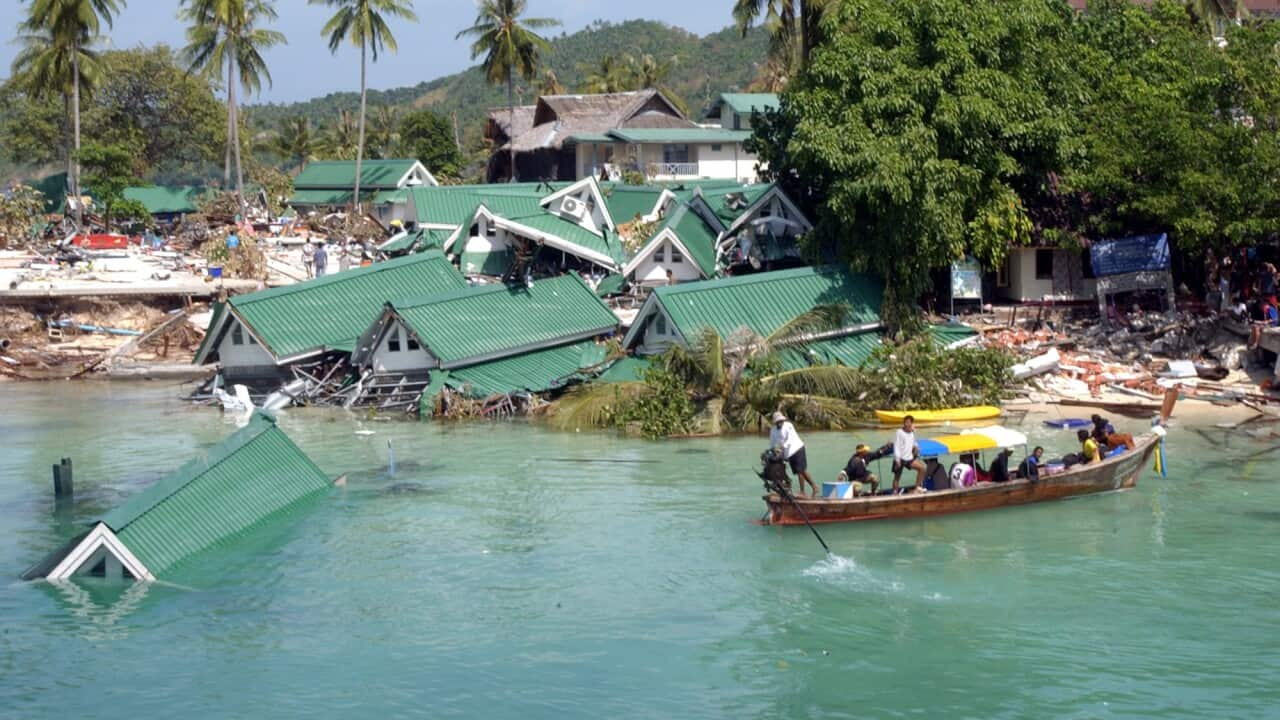Key Points
- On 26 December 2004, a devastating tsunami struck 14 countries and claimed more than 225,000 lives.
- In Thailand, the disaster triggered the world’s largest-ever disaster victim identification operation.
- Survivors say their surroundings were “unrecognisable” in the wake of the tsunami.
The morning of 26 December 2004 began quietly on Thailand’s west coast. But at 7:59am local time, a magnitude 9.0 earthquake off northern Sumatra triggered a tsunami that would devastate 14 countries and claim more than 225,000 lives.
Jirawan ‘Wan’ Chaisri, from northern Thailand, now living in Sydney, can distinctly recall the events of that day.
At the time, she was a massage therapist preparing to open a shop in Ao Nang, Krabi, when she noticed something unusual.

Jirawan ‘Wan’ Chaisri, who now lives in Sydney, survived the Boxing Day 2004 tsunami in Thailand. Credit: Supplied/Jirawan Chaisri
“Then, about 10 minutes later, everything went dark and still. No wind, no sound. It felt like the sky had swallowed the earth. And that’s when I heard people shouting, ‘Run, run! A giant wave is coming!’”

Approximately 230,000 people died in the 2004 Indian Ocean tsunami. Credit: David Longstreath/AP Photo/AAP Image
“We raced to the foothills as the wave chased us,” Wan recalled.
They sheltered overnight at Wat Tham Suea (Tiger Cave Temple). When they returned the next day, the beach was “unrecognisable”.
“No restaurants, no shops. Everything was gone,” she said.
'It was complete chaos'
As the waves subsided, chaos engulfed the towns. With no power or phone signals, communication was nearly impossible.
Titiwarada ‘Kim’ Kemp, a former radio presenter in Phuket and now a Sunshine Coast mum, recalled how the community struggled to comprehend the scale of the disaster.
“There was no mobile signal. We could only use landlines to get information from hospitals and authorities,” Kim said.
“It was complete chaos, no one knew what had happened. Everyone was in shock.”
The Thai Navy and emergency services mobilised quickly, racing to affected areas to search for survivors, tend to the injured and recover bodies.

Thai people search for bodies of their relatives at Ban Muang temple, Khao Lak district, Phang Nga province, southern Thailand on Tuesday, 28 December 2004. Credit: Rungroj Yongrit/EPA/AAP Image
On the day of the tsunami, he drove from Bangkok to Phang Nga to assist with the relief efforts.
“What we saw … nothing could have prepared me for it,” he said.
“The water had washed inland for kilometres. Debris buried so many bodies. We could only search the surface, knowing thousands remained trapped beneath. It was overwhelming.”

Pawat ‘Chicha’ Plongkham reflected on his experience as a young volunteer with the Ruamkatanyu Foundation following the 2004 tsunami in Thailand. Credit: Supplied/Pawat Plongkham
He was part of the Australian forensic team deployed to Thailand in the aftermath of the disaster.
A recipient of the Order of Australia Medal in 2014, Baines spoke to SBS Thai about the immense challenge of identifying victims.

Peter Baines (left) was a member of the Australian forensic team deployed to Thailand in the aftermath of the disaster. Credit: Hands Across the Water
“We recovered 5,395 bodies in Thailand, which remains the world’s largest-ever disaster victim identification operation."
Of the 14 affected countries, Indonesia recorded 170,000 fatalities, Sri Lanka 35,000 and India 16,000.
Rebuilding and preparedness
In the aftermath of the 2004 tsunami, Thailand recognised its lack of preparedness in the form of technology and warning systems to protect its citizens.
Since then, Thailand's Department of Disaster Prevention and Mitigation Ministry of Interior reported that the country has invested in a multi-hazard warning system, regularly conducted tsunami drills, and developed a national disaster management plan.

Thousands of foreign volunteers came to Thailand to donate weeks of their time and effort to help rebuild peoples lives after the 26 December 2004 tsunami. Credit: Barbara Walton/EPA/AAPImages
“Before 2004, our tsunami warning system was basic and mainly focused on threats from the Pacific, using information from the Tsunami Warning Centre in Hawaii,” the spokesperson said in an email.
“After the 2004 tsunami, we partnered internationally to create a unified tsunami monitoring and warning system for the Indian Ocean. Warnings can now be issued within 30 minutes of a large earthquake.”
Australia, in contrast, has not faced land-threatening tsunamis on the scale of the 2004 Indian Ocean disaster.
However, its coastline has recorded 50 incidents since European settlement, with most causing dangerous rips and currents rather than widespread land inundation.
The most recent significant event occurred on 11 March 2011, when a tsunami reached Norfolk Island, damaging multiple houses, and sweeping one away entirely.
‘A day that never leaves you’
Twenty years later, the memories of that devastating day remain vivid for those who lived through it.
Kim, who lived and worked in the affected area, still feels its weight every year.
“Every December 26th, I just wish the day would pass quickly. Even though I wasn’t directly affected, it’s a day that never leaves you,” she said.
Wan, a survivor who witnessed the destruction firsthand, said the experience carried a profound lesson.
“Don’t take anything for granted. Life can change in an instant," she said.
Listen to SBS Thai Audio on Monday and Thursday from 2pm on SBS 3. Replays from 10pm on Monday and Thursday and Saturday on SBS2. Listen to past stories from our podcast





